PONTIAC VIBE 2009 Owners Manual
Manufacturer: PONTIAC, Model Year: 2009, Model line: VIBE, Model: PONTIAC VIBE 2009Pages: 318, PDF Size: 1.53 MB
Page 251 of 318
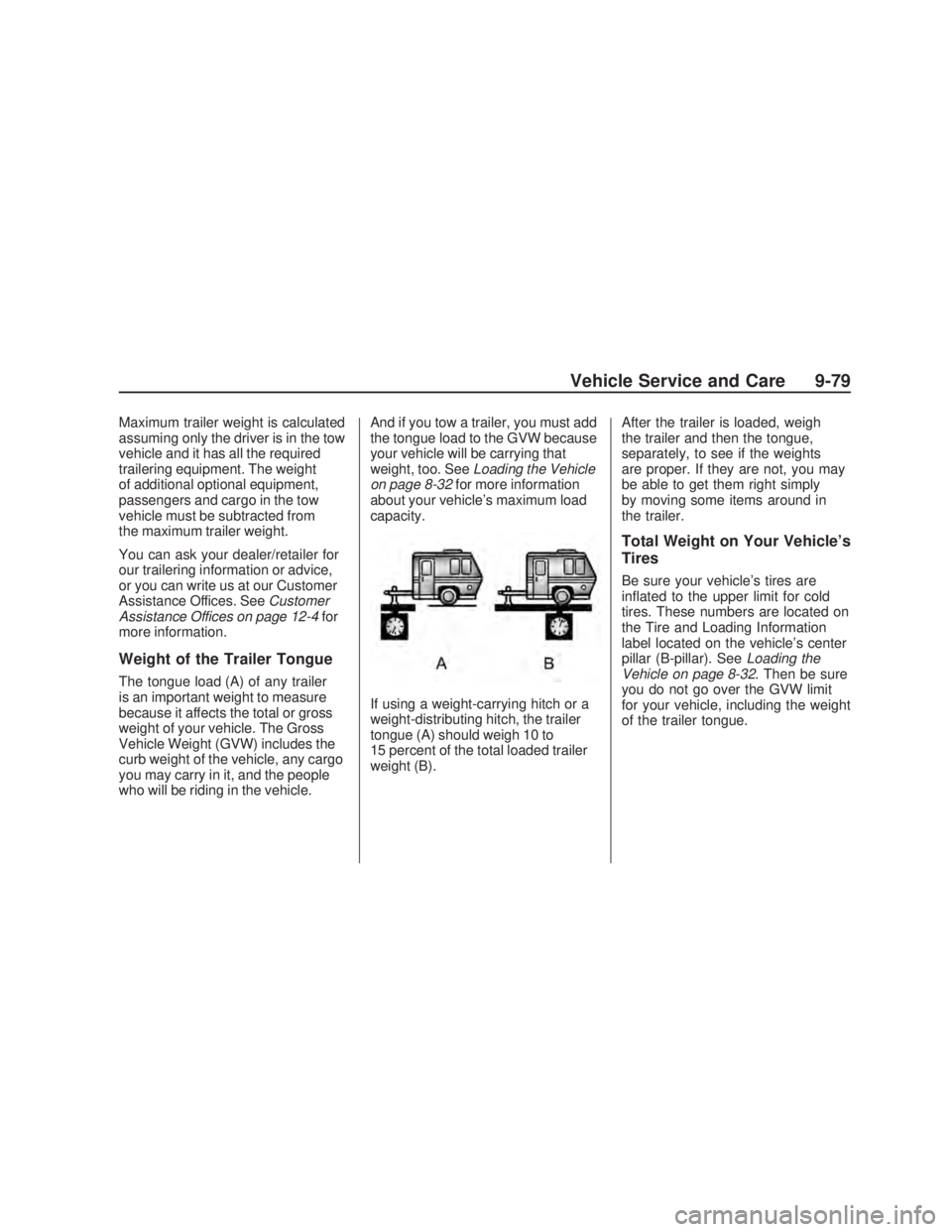
Maximum trailer weight is calculated
assuming only the driver is in the tow
vehicle and it has all the required
trailering equipment. The weight
of additional optional equipment,
passengers and cargo in the tow
vehicle must be subtracted from
the maximum trailer weight.
You can ask your dealer/retailer for
our trailering information or advice,
or you can write us at our Customer
Assistance Offices. SeeCustomer
Assistance Offices on page 12-4for
more information.
Weight of the Trailer Tongue
The tongue load (A) of any trailer
is an important weight to measure
because it affects the total or gross
weight of your vehicle. The Gross
Vehicle Weight (GVW) includes the
curb weight of the vehicle, any cargo
you may carry in it, and the people
who will be riding in the vehicle.And if you tow a trailer, you must add
the tongue load to the GVW because
your vehicle will be carrying that
weight, too. SeeLoading the Vehicle
on page 8-32for more information
about your vehicle’s maximum load
capacity.
If using a weight-carrying hitch or a
weight-distributing hitch, the trailer
tongue (A) should weigh 10 to
15 percent of the total loaded trailer
weight (B).After the trailer is loaded, weigh
the trailer and then the tongue,
separately, to see if the weights
are proper. If they are not, you may
be able to get them right simply
by moving some items around in
the trailer.
Total Weight on Your Vehicle’s
Tires
Be sure your vehicle’s tires are
in�ated to the upper limit for cold
tires. These numbers are located on
the Tire and Loading Information
label located on the vehicle’s center
pillar (B-pillar). SeeLoading the
Vehicle on page 8-32. Then be sure
you do not go over the GVW limit
for your vehicle, including the weight
of the trailer tongue.
Vehicle Service and Care 9-79
2009 - Pontiac Vibe Owner Manual
Page 252 of 318
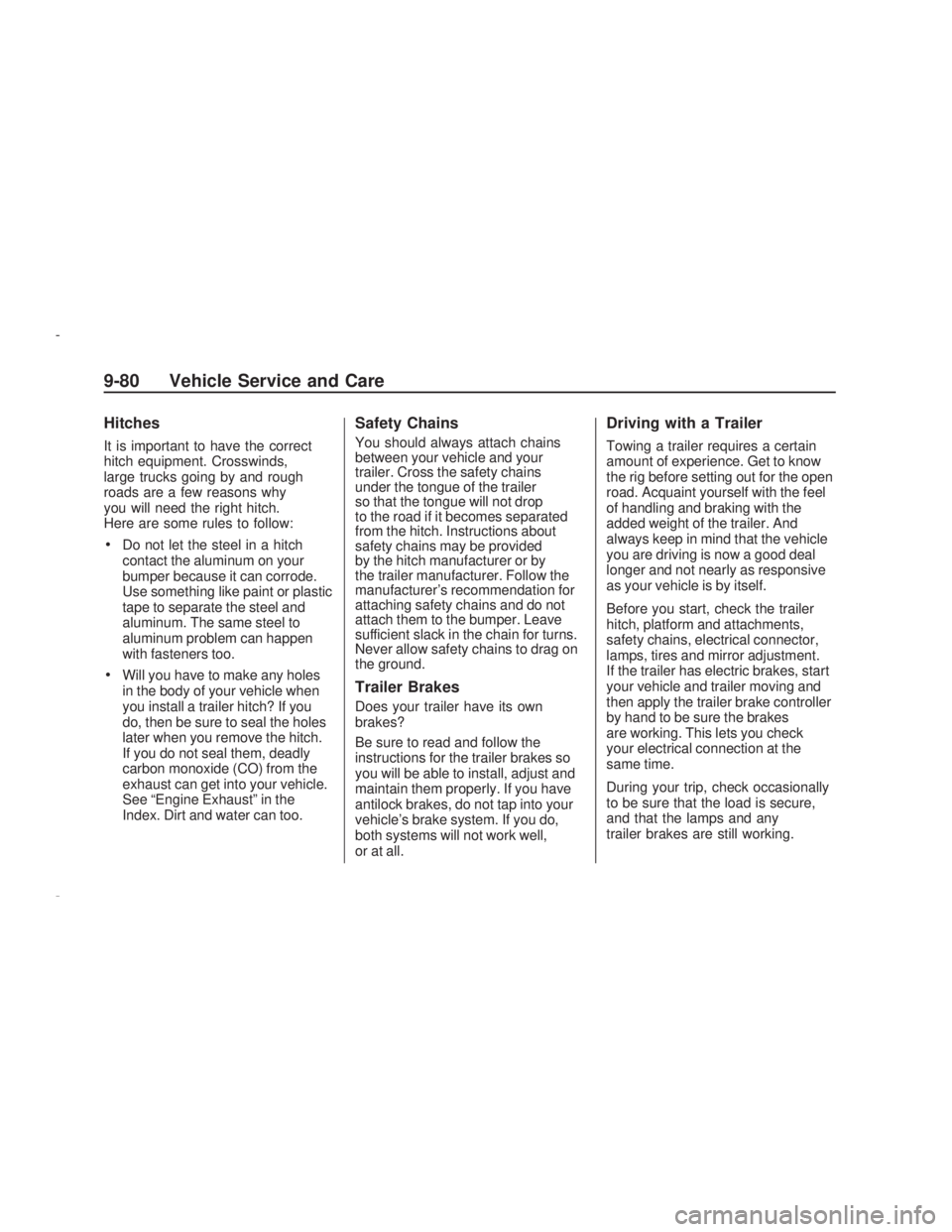
Hitches
It is important to have the correct
hitch equipment. Crosswinds,
large trucks going by and rough
roads are a few reasons why
you will need the right hitch.
Here are some rules to follow:
Do not let the steel in a hitch
contact the aluminum on your
bumper because it can corrode.
Use something like paint or plastic
tape to separate the steel and
aluminum. The same steel to
aluminum problem can happen
with fasteners too.
Will you have to make any holes
in the body of your vehicle when
you install a trailer hitch? If you
do, then be sure to seal the holes
later when you remove the hitch.
If you do not seal them, deadly
carbon monoxide (CO) from the
exhaust can get into your vehicle.
See “Engine Exhaust” in the
Index. Dirt and water can too.
Safety Chains
You should always attach chains
between your vehicle and your
trailer. Cross the safety chains
under the tongue of the trailer
so that the tongue will not drop
to the road if it becomes separated
from the hitch. Instructions about
safety chains may be provided
by the hitch manufacturer or by
the trailer manufacturer. Follow the
manufacturer’s recommendation for
attaching safety chains and do not
attach them to the bumper. Leave
sufficient slack in the chain for turns.
Never allow safety chains to drag on
the ground.
Trailer Brakes
Does your trailer have its own
brakes?
Be sure to read and follow the
instructions for the trailer brakes so
you will be able to install, adjust and
maintain them properly. If you have
antilock brakes, do not tap into your
vehicle’s brake system. If you do,
both systems will not work well,
or at all.
Driving with a Trailer
Towing a trailer requires a certain
amount of experience. Get to know
the rig before setting out for the open
road. Acquaint yourself with the feel
of handling and braking with the
added weight of the trailer. And
always keep in mind that the vehicle
you are driving is now a good deal
longer and not nearly as responsive
as your vehicle is by itself.
Before you start, check the trailer
hitch, platform and attachments,
safety chains, electrical connector,
lamps, tires and mirror adjustment.
If the trailer has electric brakes, start
your vehicle and trailer moving and
then apply the trailer brake controller
by hand to be sure the brakes
are working. This lets you check
your electrical connection at the
same time.
During your trip, check occasionally
to be sure that the load is secure,
and that the lamps and any
trailer brakes are still working.
9-80 Vehicle Service and Care
2009 - Pontiac Vibe Owner Manual
Page 253 of 318
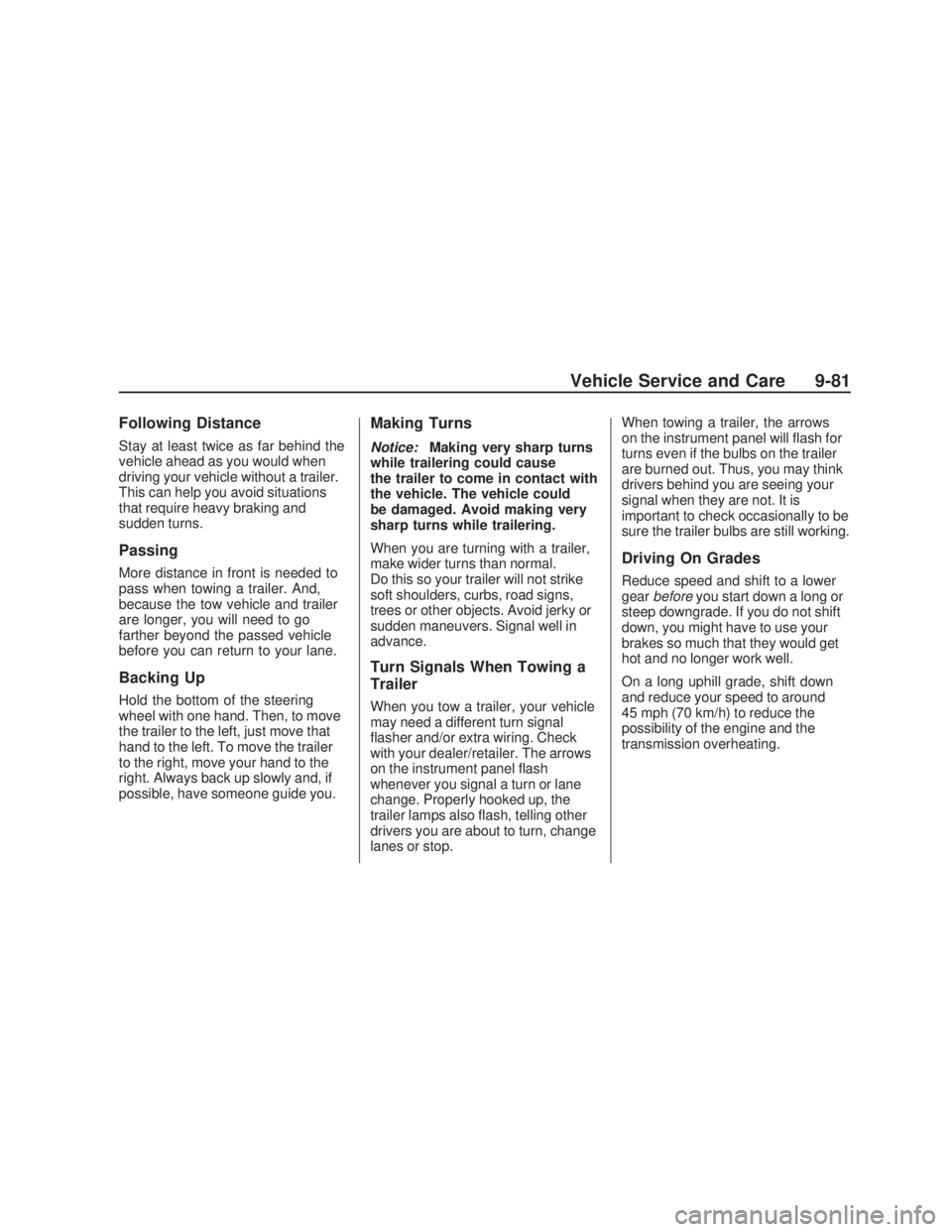
Following Distance
Stay at least twice as far behind the
vehicle ahead as you would when
driving your vehicle without a trailer.
This can help you avoid situations
that require heavy braking and
sudden turns.
Passing
More distance in front is needed to
pass when towing a trailer. And,
because the tow vehicle and trailer
are longer, you will need to go
farther beyond the passed vehicle
before you can return to your lane.
Backing Up
Hold the bottom of the steering
wheel with one hand. Then, to move
the trailer to the left, just move that
hand to the left. To move the trailer
to the right, move your hand to the
right. Always back up slowly and, if
possible, have someone guide you.
Making Turns
Notice:Making very sharp turns
while trailering could cause
the trailer to come in contact with
the vehicle. The vehicle could
be damaged. Avoid making very
sharp turns while trailering.
When you are turning with a trailer,
make wider turns than normal.
Do this so your trailer will not strike
soft shoulders, curbs, road signs,
trees or other objects. Avoid jerky or
sudden maneuvers. Signal well in
advance.
Turn Signals When Towing a
Trailer
When you tow a trailer, your vehicle
may need a different turn signal
�asher and/or extra wiring. Check
with your dealer/retailer. The arrows
on the instrument panel �ash
whenever you signal a turn or lane
change. Properly hooked up, the
trailer lamps also �ash, telling other
drivers you are about to turn, change
lanes or stop.When towing a trailer, the arrows
on the instrument panel will �ash for
turns even if the bulbs on the trailer
are burned out. Thus, you may think
drivers behind you are seeing your
signal when they are not. It is
important to check occasionally to be
sure the trailer bulbs are still working.
Driving On Grades
Reduce speed and shift to a lower
gearbeforeyou start down a long or
steep downgrade. If you do not shift
down, you might have to use your
brakes so much that they would get
hot and no longer work well.
On a long uphill grade, shift down
and reduce your speed to around
45 mph (70 km/h) to reduce the
possibility of the engine and the
transmission overheating.
Vehicle Service and Care 9-81
2009 - Pontiac Vibe Owner Manual
Page 254 of 318
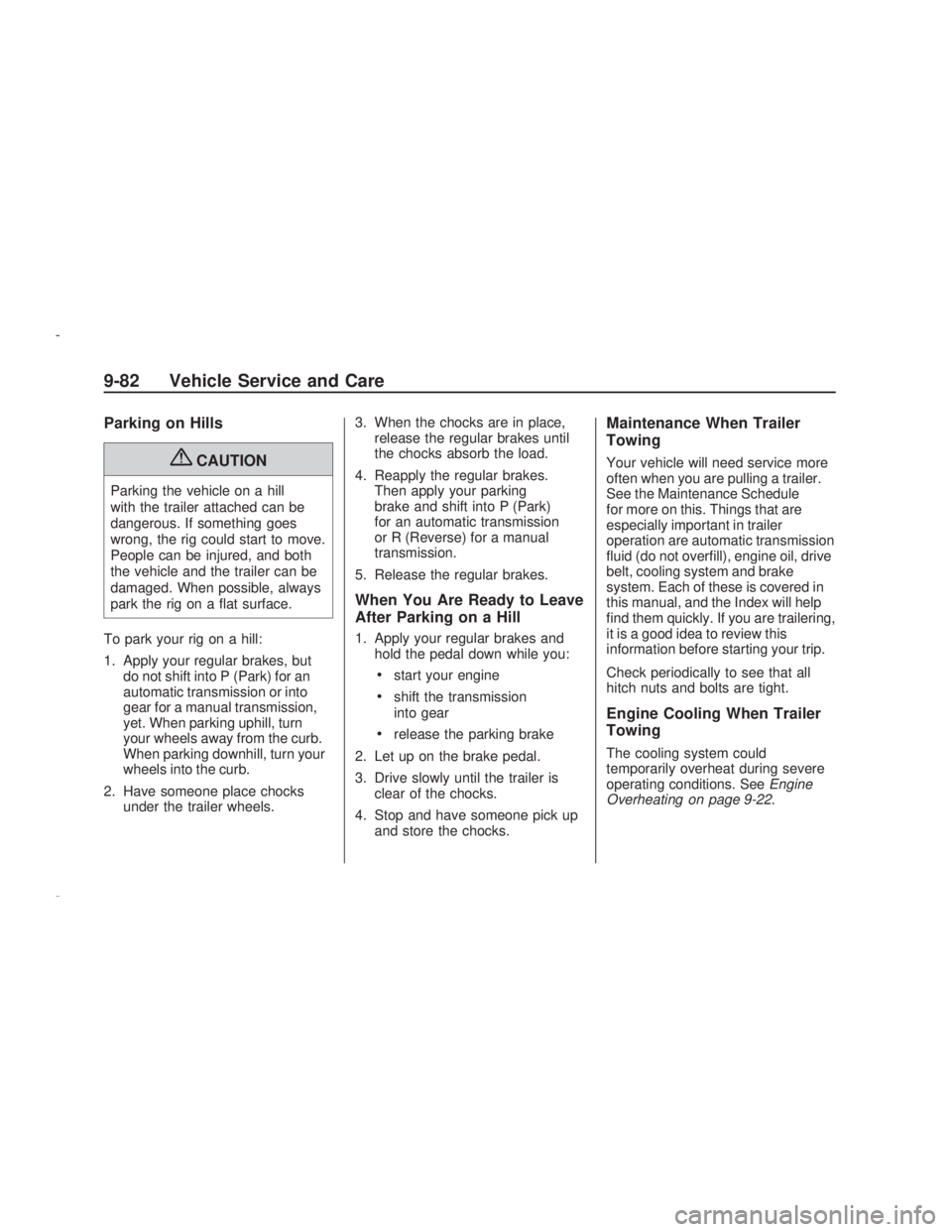
Parking on Hills
{CAUTION
Parking the vehicle on a hill
with the trailer attached can be
dangerous. If something goes
wrong, the rig could start to move.
People can be injured, and both
the vehicle and the trailer can be
damaged. When possible, always
park the rig on a �at surface.
To park your rig on a hill:
1. Apply your regular brakes, but
do not shift into P (Park) for an
automatic transmission or into
gear for a manual transmission,
yet. When parking uphill, turn
your wheels away from the curb.
When parking downhill, turn your
wheels into the curb.
2. Have someone place chocks
under the trailer wheels.3. When the chocks are in place,
release the regular brakes until
the chocks absorb the load.
4. Reapply the regular brakes.
Then apply your parking
brake and shift into P (Park)
for an automatic transmission
or R (Reverse) for a manual
transmission.
5. Release the regular brakes.
When You Are Ready to Leave
After Parking on a Hill
1. Apply your regular brakes and
hold the pedal down while you:
start your engine
shift the transmission
into gear
release the parking brake
2. Let up on the brake pedal.
3. Drive slowly until the trailer is
clear of the chocks.
4. Stop and have someone pick up
and store the chocks.
Maintenance When Trailer
Towing
Your vehicle will need service more
often when you are pulling a trailer.
See the Maintenance Schedule
for more on this. Things that are
especially important in trailer
operation are automatic transmission
�uid (do not over�ll), engine oil, drive
belt, cooling system and brake
system. Each of these is covered in
this manual, and the Index will help
�nd them quickly. If you are trailering,
it is a good idea to review this
information before starting your trip.
Check periodically to see that all
hitch nuts and bolts are tight.
Engine Cooling When Trailer
Towing
The cooling system could
temporarily overheat during severe
operating conditions. SeeEngine
Overheating on page 9-22.
9-82 Vehicle Service and Care
2009 - Pontiac Vibe Owner Manual
Page 255 of 318
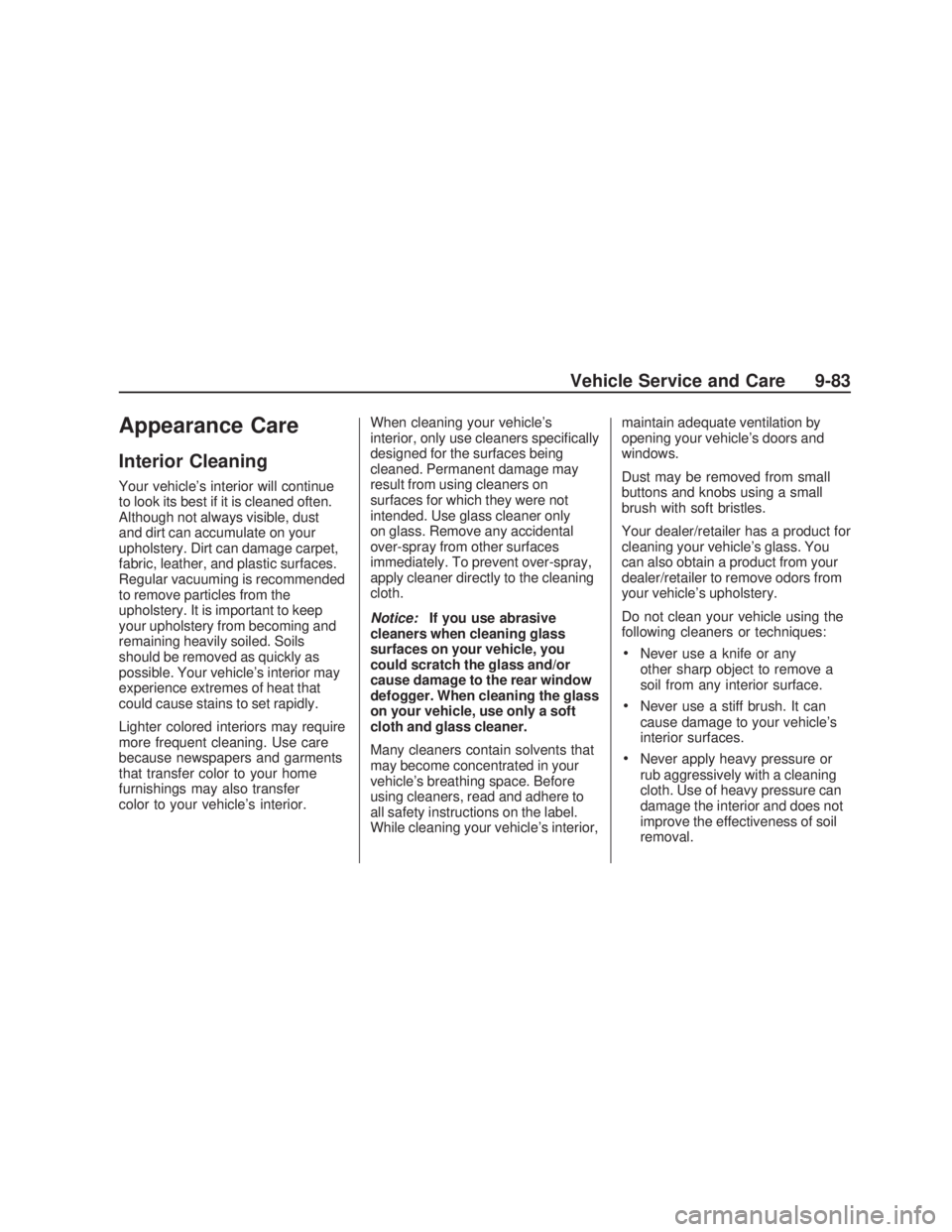
Appearance Care
Interior Cleaning
Your vehicle’s interior will continue
to look its best if it is cleaned often.
Although not always visible, dust
and dirt can accumulate on your
upholstery. Dirt can damage carpet,
fabric, leather, and plastic surfaces.
Regular vacuuming is recommended
to remove particles from the
upholstery. It is important to keep
your upholstery from becoming and
remaining heavily soiled. Soils
should be removed as quickly as
possible. Your vehicle’s interior may
experience extremes of heat that
could cause stains to set rapidly.
Lighter colored interiors may require
more frequent cleaning. Use care
because newspapers and garments
that transfer color to your home
furnishings may also transfer
color to your vehicle’s interior.When cleaning your vehicle’s
interior, only use cleaners speci�cally
designed for the surfaces being
cleaned. Permanent damage may
result from using cleaners on
surfaces for which they were not
intended. Use glass cleaner only
on glass. Remove any accidental
over-spray from other surfaces
immediately. To prevent over-spray,
apply cleaner directly to the cleaning
cloth.
Notice:If you use abrasive
cleaners when cleaning glass
surfaces on your vehicle, you
could scratch the glass and/or
cause damage to the rear window
defogger. When cleaning the glass
on your vehicle, use only a soft
cloth and glass cleaner.
Many cleaners contain solvents that
may become concentrated in your
vehicle’s breathing space. Before
using cleaners, read and adhere to
all safety instructions on the label.
While cleaning your vehicle’s interior,maintain adequate ventilation by
opening your vehicle’s doors and
windows.
Dust may be removed from small
buttons and knobs using a small
brush with soft bristles.
Your dealer/retailer has a product for
cleaning your vehicle’s glass. You
can also obtain a product from your
dealer/retailer to remove odors from
your vehicle’s upholstery.
Do not clean your vehicle using the
following cleaners or techniques:
Never use a knife or any
other sharp object to remove a
soil from any interior surface.
Never use a stiff brush. It can
cause damage to your vehicle’s
interior surfaces.
Never apply heavy pressure or
rub aggressively with a cleaning
cloth. Use of heavy pressure can
damage the interior and does not
improve the effectiveness of soil
removal.
Vehicle Service and Care 9-83
2009 - Pontiac Vibe Owner Manual
Page 256 of 318
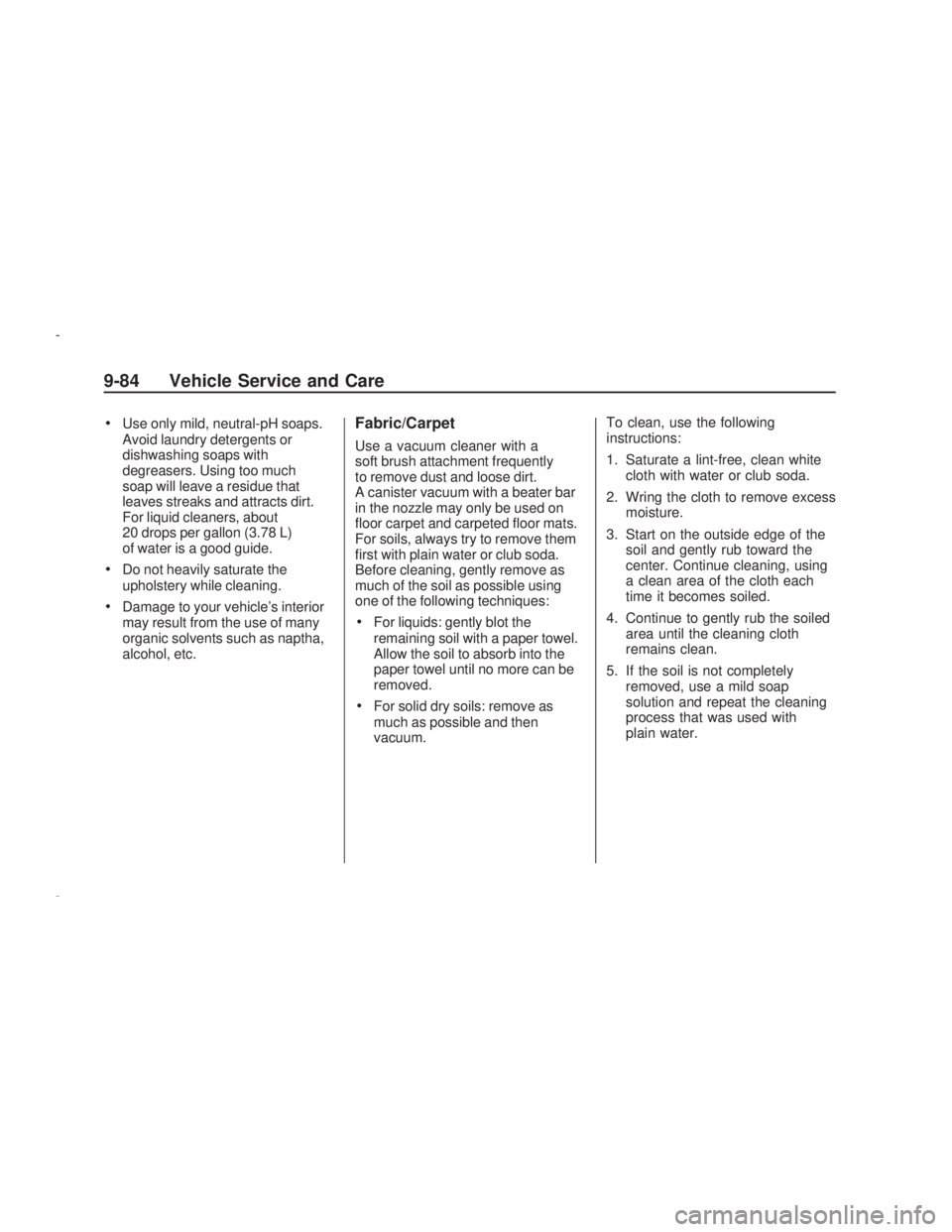
Use only mild, neutral-pH soaps.
Avoid laundry detergents or
dishwashing soaps with
degreasers. Using too much
soap will leave a residue that
leaves streaks and attracts dirt.
For liquid cleaners, about
20 drops per gallon (3.78 L)
of water is a good guide.
Do not heavily saturate the
upholstery while cleaning.
Damage to your vehicle’s interior
may result from the use of many
organic solvents such as naptha,
alcohol, etc.
Fabric/Carpet
Use a vacuum cleaner with a
soft brush attachment frequently
to remove dust and loose dirt.
A canister vacuum with a beater bar
in the nozzle may only be used on
�oor carpet and carpeted �oor mats.
For soils, always try to remove them
�rst with plain water or club soda.
Before cleaning, gently remove as
much of the soil as possible using
one of the following techniques:
For liquids: gently blot the
remaining soil with a paper towel.
Allow the soil to absorb into the
paper towel until no more can be
removed.
For solid dry soils: remove as
much as possible and then
vacuum.To clean, use the following
instructions:
1. Saturate a lint-free, clean white
cloth with water or club soda.
2. Wring the cloth to remove excess
moisture.
3. Start on the outside edge of the
soil and gently rub toward the
center. Continue cleaning, using
a clean area of the cloth each
time it becomes soiled.
4. Continue to gently rub the soiled
area until the cleaning cloth
remains clean.
5. If the soil is not completely
removed, use a mild soap
solution and repeat the cleaning
process that was used with
plain water.
9-84 Vehicle Service and Care
2009 - Pontiac Vibe Owner Manual
Page 257 of 318
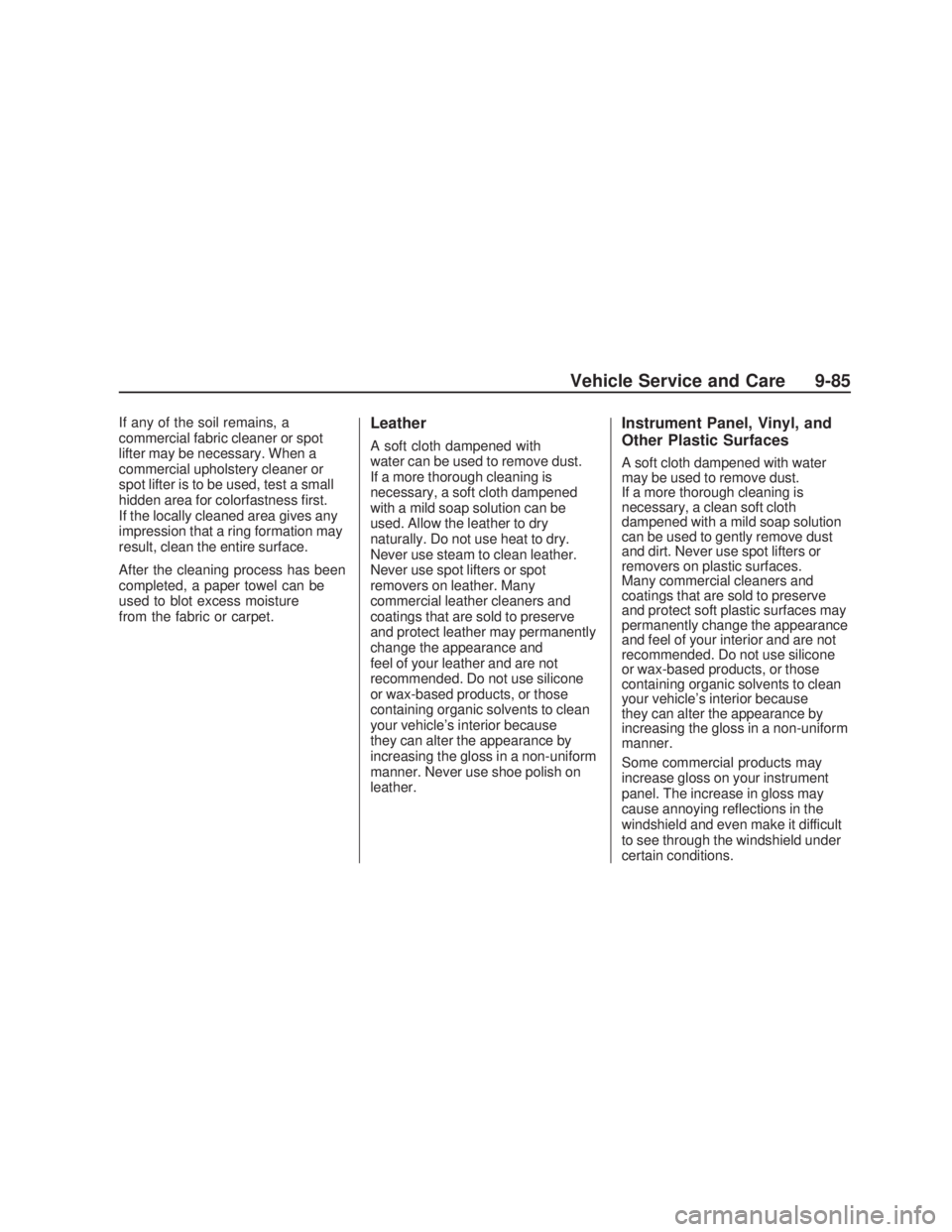
If any of the soil remains, a
commercial fabric cleaner or spot
lifter may be necessary. When a
commercial upholstery cleaner or
spot lifter is to be used, test a small
hidden area for colorfastness �rst.
If the locally cleaned area gives any
impression that a ring formation may
result, clean the entire surface.
After the cleaning process has been
completed, a paper towel can be
used to blot excess moisture
from the fabric or carpet.Leather
A soft cloth dampened with
water can be used to remove dust.
If a more thorough cleaning is
necessary, a soft cloth dampened
with a mild soap solution can be
used. Allow the leather to dry
naturally. Do not use heat to dry.
Never use steam to clean leather.
Never use spot lifters or spot
removers on leather. Many
commercial leather cleaners and
coatings that are sold to preserve
and protect leather may permanently
change the appearance and
feel of your leather and are not
recommended. Do not use silicone
or wax-based products, or those
containing organic solvents to clean
your vehicle’s interior because
they can alter the appearance by
increasing the gloss in a non-uniform
manner. Never use shoe polish on
leather.
Instrument Panel, Vinyl, and
Other Plastic Surfaces
A soft cloth dampened with water
may be used to remove dust.
If a more thorough cleaning is
necessary, a clean soft cloth
dampened with a mild soap solution
can be used to gently remove dust
and dirt. Never use spot lifters or
removers on plastic surfaces.
Many commercial cleaners and
coatings that are sold to preserve
and protect soft plastic surfaces may
permanently change the appearance
and feel of your interior and are not
recommended. Do not use silicone
or wax-based products, or those
containing organic solvents to clean
your vehicle’s interior because
they can alter the appearance by
increasing the gloss in a non-uniform
manner.
Some commercial products may
increase gloss on your instrument
panel. The increase in gloss may
cause annoying re�ections in the
windshield and even make it difficult
to see through the windshield under
certain conditions.
Vehicle Service and Care 9-85
2009 - Pontiac Vibe Owner Manual
Page 258 of 318
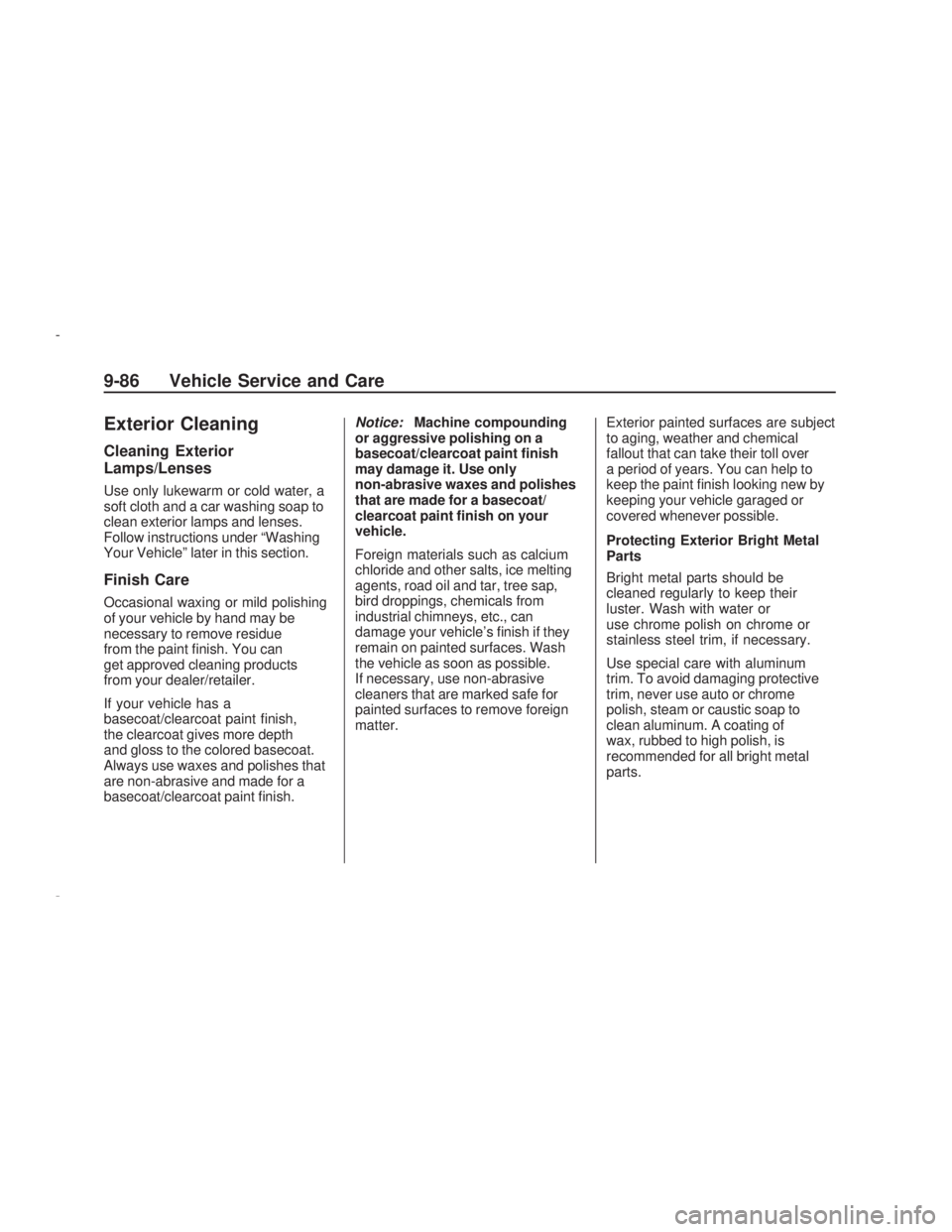
Exterior Cleaning
Cleaning Exterior
Lamps/Lenses
Use only lukewarm or cold water, a
soft cloth and a car washing soap to
clean exterior lamps and lenses.
Follow instructions under “Washing
Your Vehicle” later in this section.
Finish Care
Occasional waxing or mild polishing
of your vehicle by hand may be
necessary to remove residue
from the paint �nish. You can
get approved cleaning products
from your dealer/retailer.
If your vehicle has a
basecoat/clearcoat paint �nish,
the clearcoat gives more depth
and gloss to the colored basecoat.
Always use waxes and polishes that
are non-abrasive and made for a
basecoat/clearcoat paint �nish.Notice:Machine compounding
or aggressive polishing on a
basecoat/clearcoat paint �nish
may damage it. Use only
non-abrasive waxes and polishes
that are made for a basecoat/
clearcoat paint �nish on your
vehicle.
Foreign materials such as calcium
chloride and other salts, ice melting
agents, road oil and tar, tree sap,
bird droppings, chemicals from
industrial chimneys, etc., can
damage your vehicle’s �nish if they
remain on painted surfaces. Wash
the vehicle as soon as possible.
If necessary, use non-abrasive
cleaners that are marked safe for
painted surfaces to remove foreign
matter.Exterior painted surfaces are subject
to aging, weather and chemical
fallout that can take their toll over
a period of years. You can help to
keep the paint �nish looking new by
keeping your vehicle garaged or
covered whenever possible.
Protecting Exterior Bright Metal
Parts
Bright metal parts should be
cleaned regularly to keep their
luster. Wash with water or
use chrome polish on chrome or
stainless steel trim, if necessary.
Use special care with aluminum
trim. To avoid damaging protective
trim, never use auto or chrome
polish, steam or caustic soap to
clean aluminum. A coating of
wax, rubbed to high polish, is
recommended for all bright metal
parts.
9-86 Vehicle Service and Care
2009 - Pontiac Vibe Owner Manual
Page 259 of 318
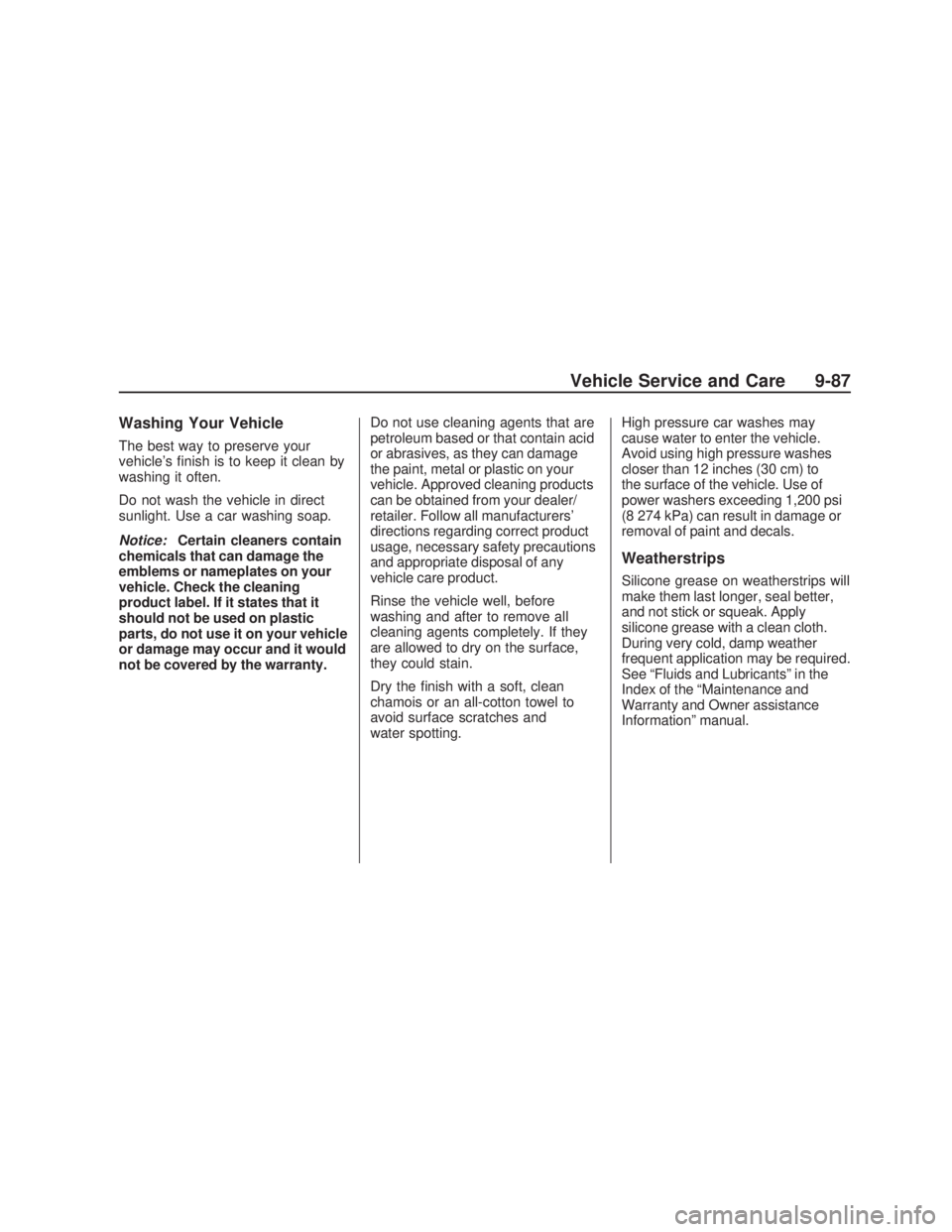
Washing Your Vehicle
The best way to preserve your
vehicle’s �nish is to keep it clean by
washing it often.
Do not wash the vehicle in direct
sunlight. Use a car washing soap.
Notice:Certain cleaners contain
chemicals that can damage the
emblems or nameplates on your
vehicle. Check the cleaning
product label. If it states that it
should not be used on plastic
parts, do not use it on your vehicle
or damage may occur and it would
not be covered by the warranty.Do not use cleaning agents that are
petroleum based or that contain acid
or abrasives, as they can damage
the paint, metal or plastic on your
vehicle. Approved cleaning products
can be obtained from your dealer/
retailer. Follow all manufacturers’
directions regarding correct product
usage, necessary safety precautions
and appropriate disposal of any
vehicle care product.
Rinse the vehicle well, before
washing and after to remove all
cleaning agents completely. If they
are allowed to dry on the surface,
they could stain.
Dry the �nish with a soft, clean
chamois or an all-cotton towel to
avoid surface scratches and
water spotting.High pressure car washes may
cause water to enter the vehicle.
Avoid using high pressure washes
closer than 12 inches (30 cm) to
the surface of the vehicle. Use of
power washers exceeding 1,200 psi
(8 274 kPa) can result in damage or
removal of paint and decals.
Weatherstrips
Silicone grease on weatherstrips will
make them last longer, seal better,
and not stick or squeak. Apply
silicone grease with a clean cloth.
During very cold, damp weather
frequent application may be required.
See “Fluids and Lubricants” in the
Index of the “Maintenance and
Warranty and Owner assistance
Information” manual.
Vehicle Service and Care 9-87
2009 - Pontiac Vibe Owner Manual
Page 260 of 318
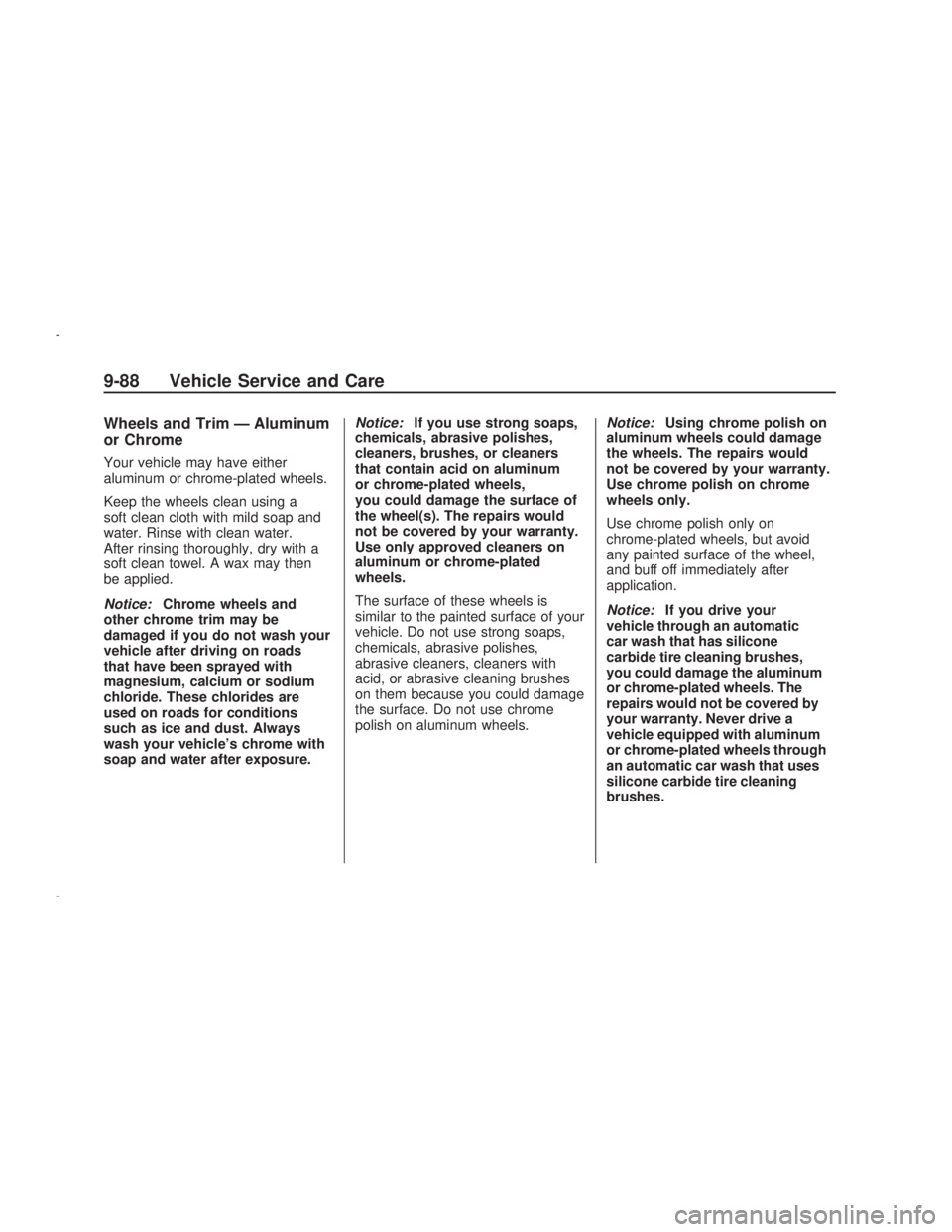
Wheels and Trim — Aluminum
or Chrome
Your vehicle may have either
aluminum or chrome-plated wheels.
Keep the wheels clean using a
soft clean cloth with mild soap and
water. Rinse with clean water.
After rinsing thoroughly, dry with a
soft clean towel. A wax may then
be applied.
Notice:Chrome wheels and
other chrome trim may be
damaged if you do not wash your
vehicle after driving on roads
that have been sprayed with
magnesium, calcium or sodium
chloride. These chlorides are
used on roads for conditions
such as ice and dust. Always
wash your vehicle’s chrome with
soap and water after exposure.Notice:If you use strong soaps,
chemicals, abrasive polishes,
cleaners, brushes, or cleaners
that contain acid on aluminum
or chrome-plated wheels,
you could damage the surface of
the wheel(s). The repairs would
not be covered by your warranty.
Use only approved cleaners on
aluminum or chrome-plated
wheels.
The surface of these wheels is
similar to the painted surface of your
vehicle. Do not use strong soaps,
chemicals, abrasive polishes,
abrasive cleaners, cleaners with
acid, or abrasive cleaning brushes
on them because you could damage
the surface. Do not use chrome
polish on aluminum wheels.Notice:Using chrome polish on
aluminum wheels could damage
the wheels. The repairs would
not be covered by your warranty.
Use chrome polish on chrome
wheels only.
Use chrome polish only on
chrome-plated wheels, but avoid
any painted surface of the wheel,
and buff off immediately after
application.
Notice:If you drive your
vehicle through an automatic
car wash that has silicone
carbide tire cleaning brushes,
you could damage the aluminum
or chrome-plated wheels. The
repairs would not be covered by
your warranty. Never drive a
vehicle equipped with aluminum
or chrome-plated wheels through
an automatic car wash that uses
silicone carbide tire cleaning
brushes.
9-88 Vehicle Service and Care
2009 - Pontiac Vibe Owner Manual